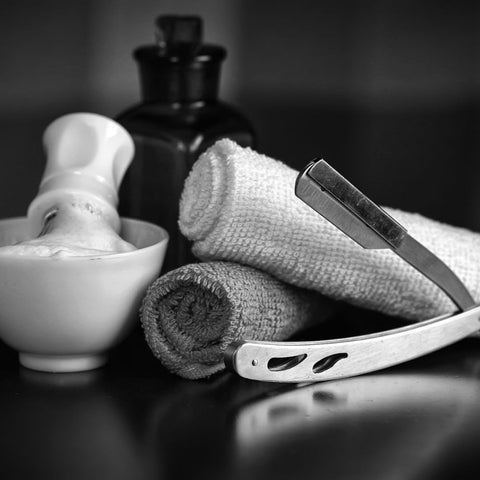Shopping for and Using a Straight Razor for the Closest Shave
If you're looking for a traditional and close shave, a straight razor may be the perfect choice for you. These razors feature a sharp, straight blade that can be folded into a handle for easy storage. However, before you start shopping for a straight razor, there are a few things you should consider to ensure you get the best razor for your needs and learn how to use it properly.

-
Blade Material: The most common materials for straight razor blades are carbon steel and stainless steel. Carbon steel blades are known for their sharpness and easy maintenance, but they do require more care to prevent rust and discoloration. Stainless steel blades, on the other hand, are more resistant to rust and discoloration, but they may not be as sharp as carbon steel blades.
-
Handle Material: The handle of a straight razor can be made from a variety of materials, including wood, bone, horn, and plastic. It's important to choose a handle that feels comfortable in your hand and provides a secure grip.
-
Grind: The grind of a straight razor refers to the way the blade is shaped and honed. The most common grinds are full hollow, half hollow, and quarter hollow. Full hollow grinds provide the most flexibility and are great for beginners, while half and quarter hollow grinds offer more stability and are better for experienced shavers.
-
Point: The point of a straight razor refers to the shape of the tip of the blade. The most common points are round, square, and French. Round points are great for beginners as they are less likely to cut yourself. Square points are more aggressive and better for experienced shavers while French points are more versatile and can be used by both beginners and experienced shavers.
- Size: The size of the straight razor can vary, but most razors are between 5/8 and 7/8 inches wide. The size you choose will depend on your personal preference and the size of your hand.
It's worth considering the Saki Shears straight razor. This razor boasts a beautiful ebony wood handle and brass accents, setting it apart from other straight razors on the market. The razor is also made with high-quality stainless steel, ensuring durability and longevity. The Saki Shears straight razor also includes a robust shank sleeve that wraps around the razor blade, securing it in place and preventing it from moving around while you shave. The razor kit comes with 10 disposable razor blades. The precision and control that is possible with the Saki Shears straight razor is unparalleled. It gives you the ability to create precise lines and angles, and the weight and balance of the razor make it easy to maneuver and control.
Once you have your straight razor, it's important to take the time to learn how to use it properly. Here's a step-by-step guide for shaving with a straight razor for the first time:
-
Prepare your skin: Before shaving, it's important to prepare your skin by cleaning it and softening your hair. Take a warm shower or use a hot towel to open up your pores and soften your hair.
-
Lather up: Use a shaving brush and a quality shaving cream or soap to create a thick lather. Apply the lather to your face in circular motions, making sure to cover all areas you plan to shave.
-
Hold the razor correctly: Hold the straight razor with your index and middle fingers on the tang (the part of the razor that extends into the handle) and your thumb on the back of the blade. The blade should be at a 30-degree angle to your skin.
-
Start with the grain: Begin shaving with the grain of your hair, which is the direction your hair grows. Make sure to use light, short strokes and to keep the blade at a 30-degree angle to your skin.
-
Shave against the grain: Once you've finished shaving with the grain, you can go against the grain for a closer shave. However, be very careful when shaving against the grain as it can be more aggressive and can increase the risk of irritation and nicks.
-
Rinse your face: Rinse your face with cold water to close your pores and remove any remaining lather.
-
Moisturize: Apply a moisturizer or aftershave to soothe your skin and prevent irritation.
A few things to keep in mind when shaving with a straight razor:
- Always use a sharp blade. A dull blade can cause irritation and increase the risk of cuts and nicks.
- Take your time. Rushing through a shave can increase the risk of accidents.
- Use light pressure. The weight of the razor is enough to cut the hair, there's no need to apply pressure.
- Shave in a well-lit area. This will help you to see any missed spots or areas that require touch-ups.
- Shave only when your hair is wet. Shaving dry hair can cause irritation and increase the risk of cuts and nicks.
- Remember to strop and sharpen your blade regularly.
In summary, when shopping for a straight razor, consider the blade material, handle material, grind, point, and size. And once you have it, take the time to learn how to sharpen and strop it, keep it clean, and use the right products to prepare your skin before shaving. With the right razor and techniques, a straight razor can provide a close, smooth, and traditional shave. It's important to start slowly and practice the above steps, and with time and experience, you will become a master of the straight razor. Remember that it's not about how many times you cut yourself, it's about how many times you didn't.















